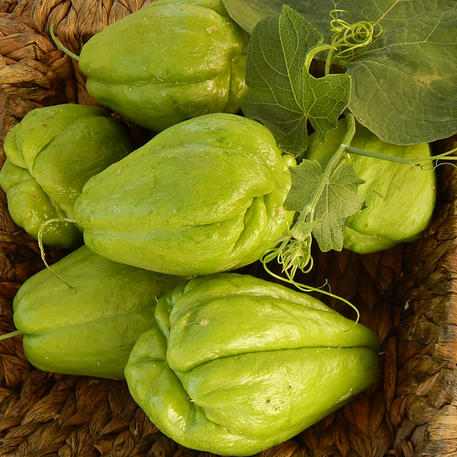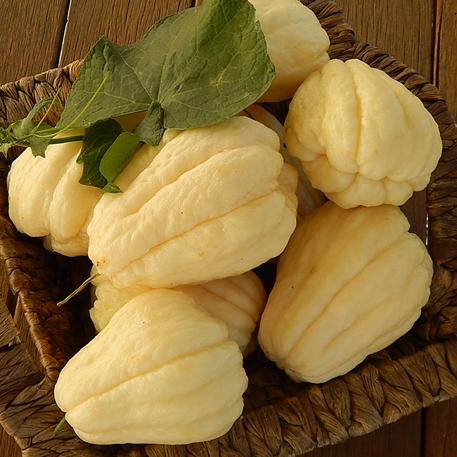-
Filter By Stock
- In Stock (0)
CHOKO
BOTANICAL NAME: Sechium edule
COMMON NAMES: Chayote, Alligator Pear, Mirliton, or in Chinese In China, it is referred to as fóshǒuguā, meaning 'Buddha's Palms Melon'. In India, the fruit is called chow chow among other names.
FAMILY: Cucurbitaceae
ORIGIN: First cultivated in Mesoamerica between southern Mexico and Honduras. It is one of the foods introduced to the Old World during the Columbian Exchange. At the time, the plant then spread to other parts of the Americas, eventually causing it to be integrated into the cuisine of many Latin American dishes.
PLANT DESCRIPTION
Generally, the choko fruit is roughly pear-shaped, somewhat flattened and with coarse wrinkles, ranging from 10 to 25 cm in length, with thin green skin fused with green to white flesh, and a single, large, flattened seed. Some varieties have spiny fruit. Depending on the variety, a single fruit can weigh up to 1.2 kg. The flesh has a fairly bland taste, and the texture is described as a cross between a potato and a cucumber.
The plant bears male flowers in clusters and solitary female flowers.
USES
The fruit is mostly used cooked in similar ways to button squash and zucchini. Raw choko may also be grated, marinated with lemon juice and then added to salads and salsas. The fruit can vary in flavour, from bland or starchy to sweetish, depending on the cultivar. Chokos are a good source of Vitamin C.
The plants root, stem, seeds and leaves are edible as well and used like asparagus. The tubers of the plant are prepared like potatoes and other root vegetables, while the shoots and leaves are often consumed in salads and stir fries, especially in Asian cuisine. Choko's leaves and stems are a good source of iron, carotene, thiamine, riboflavin and niacin.
Due to its purported cell-regenerative properties, it is believed as a contemporary legend that the choko fruit caused the mummification of people from the Colombian town of San Bernardo who extensively consumed it. Compared to other similar findings, the mummies have very well preserved skin and flesh.
Fibres from the stem have been used to make baskets and hats and, as reported from Ghana, as binding material in the construction of mud houses.
Dried vines may be used for basket weaving
GROWING TIPS
The choko plant has a vining habit, and requires trellising. The roots are also highly susceptible to rot, especially in containers, however the plant is generally easy to grow. Many home gardeners grow the plant on a chicken wire support or strung against a fence. Plants should be spaced 1m apart.
Seed - keep the seed inside the fruit when sowing. A mature fruit, with the germinating seed inside, should be planted to a depth of two thirds of its length with its widest end down. Stem cuttings 15 - 20cm long are also an effective form of propagation. They should be planted in a shady position and kept moist until they have rooted.
PLANTING GUIDE
Choko plants require humus-rich, well drained soils, which are slightly acid to acid (pH 4.5 to 6.5). Clay soils reduce crop productivity because they retain water and therefore promote growth of fungal pests. Chokos adapt to a wide range of climatic conditions but grows best in regions with average temperatures of 13°-21 °C. Plants are not frost-tolerant, however they may be grown as an annual in temperate regions. In cooler areas plants will die back in winter however will reshoot in spring.

CHOKO - Green
***NOT TAS, WA*** (Sechium edule) Heirloom from Mexico. Also known a 'Chayote' or 'Vegetable Pear'. Perennial. Annual in cooler areas. Large, gr
$4.95

CHOKO - White
***NOT TAS, WA*** (Sechium edule) Rare heirloom from Mexico. Also known a 'Chayote' or 'Vegetable Pear'. Perennial. Annual in cooler area
$6.95
